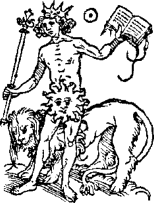Correspondences
Within hierarchies there were "correspondences": created beings whose status within the hierarchy were equivalent one to the other. Consider, for example, those at the head of each category:
| The angels | God |
| The universe | Sun |
| Society | King |
| The family | Husband |
| The human body | The head |
| Animals | Lion |
| Plants | Oak |
| Minerals | Gold* |
The list of such correspondences could be extended almost indefinitely.
Shakespeare and the correspondences
The imagery of medieval and Renaissance literature is deeply influenced by these correspondences. Just before he is deposed, Richard II appears before the forces of Henry Bolingbroke, later to become Henry IV; Henry and the Duke of York comment:
Bolingbroke: See, see, King Richard doth himself appear,
As doth the blushing discontented sun*
From out the fiery portal of the East,
When he perceives the envious clouds are bent
To dim his glory, and to stain the track
Of his bright passage to the Occident [west].
York: Yet looks he like a king: behold his eye,
As bright as is the eagle's, lightens forth
Controlling majesty.
(Richard II, 3.3.61-69)
Footnotes
-
The noblest metal
Gold is still called a "noble" metal because it does not tarnish. Other metals were seen as gold mixed with impurities; hence the alchemists believed that they could refine them into gold.
-
Imitating the sun
Compare the same imagery used by Bolingbroke's son, the errant Prince Hal, as he justifies his time spent (or mis-spent) with Falstaff:
. . .herein will I imitate the sun,
Who doth permit the base contagious clouds
To smother up his beauty from the world,
That, when he please again to be himself,
Being wanted, he may be more wond'red at
By breaking through the foul and ugly mists
Of vapours that did seem to strangle him.
(Henry IV, Part One, 1. 2. 194-200)
